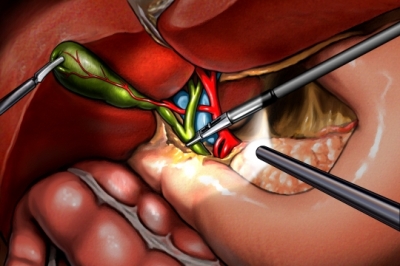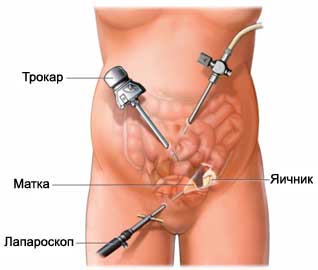Robotic Laparoscopic Surgery
Robotïzïrovannaya cardiac surgery – Robotic surgery in heart surgery
Robotizirovannaya surgery – brief overview
Description of robotic laparoscopic surgery
During the surgery, the doctor uses robotic manipulators, allowing surgical intervention through small incisions in the abdomen.
Manipulators can perform surgeries with increased range of motion. Also, robotic surgery avoids tremors., which is present during the operation by the surgeon. Special tools allow you to carry out operations with increased accuracy. This is especially important in the limited space of some parts of the body..

Reasons for robotic laparoscopic surgery
Laparoscopic operations, in which robotic methods are successfully applied include:
- Adrenalэktomiya – removal of the adrenal gland;
- Appendectomy – the removal of the appendix;
- Bariatricheskaya surgery – stomach surgery to treat obesity;
- Cholecystectomy – removal of the gallbladder;
- Colorectal procedures;
- Treatment of hernia;
- Nephrectomy – removal of a kidney;
- Fundoplikaciâ – surgical strengthening of the valve between the esophagus and stomach;
- Prostatectomy – removal of the prostate;
- Hysterectomy – hysterectomies (as a result of infertility);
- Myomectomy – removal of fibroids (benign tumors in the wall of the uterus).
Compared to traditional procedures, the advantages of robotic laparoscopic surgery are as follows:
- Reduced scarring;
- Reduced recovery time;
- Less risk of infection;
- Low blood loss;
- Reduced trauma to the body;
- Shorter hospital stay;
- Fast recovery.
Possible complications of robotic laparoscopic surgery
Complications are rare, but no procedure does not guarantee the absence of risk. If robotic laparoscopic surgery is planned, you need to know about possible complications, which may include:
- Damage to neighboring organs or structures;
- Infection;
- Bleeding;
- Problems, associated with anesthesia;
- The need to switch to traditional surgical methods (eg, traditional laparoscopic or open surgery).
Factors, that may increase the risk of complications:
- Smoking;
- Existing heart or lung disease;
- Obesity;
- Diabetes;
- Excessive alcohol consumption;
- Previous abdominal or pelvic surgery;
- The use of some drugs.
We need to discuss these risks with your doctor before the procedure.
How is robotic laparoscopic surgery performed??
Preparation for the procedure
Depending on the reason for the operation, your doctor may prescribe or to hold the next:
- Medical checkup;
- Blood tests;
- Urine;
- Electrocardiogram – test, which records electrical currents, passing through the heart muscle;
- Intravenous pyelogram – type of X-ray, in which pictures of the kidneys, the ureters and bladder are performed after a special dye is injected into the bloodstream;
- X-ray of the abdomen – Photos pochek, mochetochnika, Bladder;
- Abdominal ultrasound or US pelvic – test, that uses sound waves to visualize the inside of the body;
- CT of the abdomen – such as X-rays, who uses a computer to photograph structures in the abdomen or pelvis.
In the run-up procedure:
- Consult your doctor about the drugs taken. A week before surgery you may be asked to stop taking some medicines:
- Anti-inflammatory drugs (eg, aspirin);
- Blood thinners, such as clopidogrel (Plaviks) or warfarin;
- As a physician you need to take antibiotics;
- Take a laxative and / or use an enema, to cleanse the bowel, if it is recommended by your doctor;
- Follow a special diet, as indicated by a physician;
- Shower with antibacterial soap before surgery;
- We need to organize a trip for the operation and back home from the hospital. Besides, arrange home help for the recovery period;
- In the evening before the operation can be only a light meal. Do not eat or drink anything the night, unless permitted by a doctor.
Anesthesia
During the robotic surgery may include the following types of anesthesia:
- General anesthesia – blocks any pain and the patient support in a sleep state during operation. Administered intravenously in the arm or hand;
- Local anesthesia – anaesthetises body, during surgery, the patient is awake. It is used as an injection. Sometimes it can be used in conjunction with sedatives.
Description of the robotic laparoscopic surgery procedure
Several small cuts will be made. Through one of the incisions will be pumped carbon dioxide, to facilitate visibility inside the body.

A small camera will be introduced into the operated area through one of the incisions.. For these purposes the tool, which is called an endoscope. There is also a light source at the end of the endoscope, and the camera sends an image of the screen. The endoscope will be attached to one of the arms of the robotic surgery machine. Other manipulators hold tools, with which you can cut, prune and suture. They may include:
- Tongs;
- Scissors;
- Dissector;
- Scalpels.
Sitting at the controls next to the operating table, the doctor will see on the monitor a three-dimensional image of organs inside the body. The control console has a joystick to control the manipulators. With their help, the doctor controls the position of the camera and the operation of surgical instruments.. The surgeon's assistant is near the operating table and adjusts the camera and instruments on the manipulators as needed. In some cases, affected tissues and organs can be removed. After the operation is completed, manipulators will be removed, the incision is closed.
How long will robotic laparoscopic surgery take?
About 1-2 hours (depending on the type of procedure).
Robotic Laparoscopic Surgery – Will it hurt?
You will experience pain and discomfort during recovery. The doctor will give you pain medicine. You may also feel some “inflation” or pain in your shoulder from the gas, used during the procedure. The discomfort may last up to three days.
Average hospital stay after robotic laparoscopic surgery
The procedure is performed in a hospital. Usually the duration of stay of 1-2 day. If complications arise, length of stay in the hospital can be extended.
Care after robotic laparoscopic surgery
When you return home, Follow these steps:, to ensure the normal recovery:
- Wash your incisions with mild soap and water.;
- We need to ask the doctor, when it is safe to shower, bathe or expose the surgical site to water;
- We need to take antibiotics, to prevent infection, if it is indicated doctor;
- You may have to stop taking certain medications;
- Perform daily walks. This will help restore. You should avoid vigorous activity, such as driving, having sex, physical exertion;
- You need to gradually move from liquid to solid food;
- To avoid constipation:
- Consume fiber-rich foods;
- Drink plenty of water;
- Use stool softeners;
- Be sure to follow your doctor's instructions.
Depending on the procedure, full recovery can take several weeks.
Communication with the doctor after robotic laparoscopic surgery
After returning home, you need to see a doctor, If the following symptoms:
- Signs of infection, including fever and chills
- Redness, edema, increased pain, bleeding or discharge from the incision;
- Bloating and abdominal pain;
- Severe nausea and vomiting;
- Persistent diarrhea or constipation;
- Blood in the stool;
- Pain and / or swelling of the legs, calves and feet;
- Cough, breathlessness, chest pain;
- Difficulty urinating, such as pain, burning, frequent urge, or persistent blood in the urine;
- Inability to eat and drink liquids;
- Headache, a feeling of weakness or dizziness;
- Excessive vaginal bleeding after a gynecological robotic laparoscopic procedure
- Persistent or unpleasant odor of vaginal discharge after gynecological surgery;
- Other worrisome symptoms.
